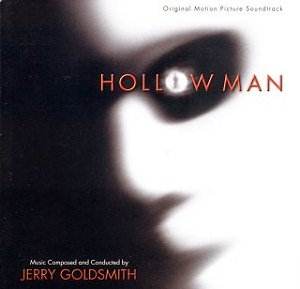Jerry GOLDSMITH
Hollowman
 OST
OST
 VARÈSE SARABANDE VSD-6171
[51:31]
VARÈSE SARABANDE VSD-6171
[51:31]

Following Total Recall and Basic Instinct, Hollow
Man is Jerry Goldsmith's third film with director Paul Verhoven. It
is also Verhoven's fourth Hollywood SF movie, coming after Robocop, Total
Recall and Starship Troopers. Verhoven films are famed for
their extreme violence (and sometimes, graphic sex), and noted for a satirical,
outsider's interpretation of standard American genre tropes (Verhoven is
Dutch). He is the complete film-maker, concerned with every aspect of his
movies, sufficiently so that they have such a distinctive personality we
might call him an auteur. This level of involvement extends to his
understanding of the importance of music, such that we can all but take it
for granted that a Paul Verhoven film will sport a superior musical score.
Exactly a decade ago, Goldsmith graced Total Recall with a score
which many consider a landmark. I wouldn't rate it that highly, but it is
a powerful work which greatly enhances the film. They reunited for the director's
next film, Basic Instinct, the result a cool, elegant, slyly witty
post-Hitchcockian thriller for which Goldsmith penned a cool, elegant and
sensual post-Herrmann score. It remains one of Goldsmith's finest achievements
of the 1990's. So, expectations are high for Hollow Man, a typically
bloody and pyrotechnic Verhoven vehicle which reworks H.G. Well's The
Invisible Man into a showcase for the state-of-the CGI art.
On playing this CD the initial reaction may be one of disappointment. This
is a slow-burning score which takes several spins to burrow its way into
the subconscious, and contains considerably more subtlety than is first apparent.
The main theme perhaps deliberately evokes the iciness of Basic
Instinct, while the following early suspense cues make much of striking
high violin writing, building musical drama around propulsive motifs which
echo the muscularity of late 70's Goldsmith SF scores: 'Isabelle Comes Back'
will resonate with anyone whose memory extends back to Capricorn One.
This is a fine 6:04 long set-piece, leading to an attractive and nicely
underplayed love theme, while 'This is Science' is another 6-minute plus
suspense cue with a neo-baroque clarity to its interwoven lines, developing
at the halfway mark into a passage evocative of the composer's rugged The
Edge.
Very much an album of two halves, the all-action slaughter is played out
through the closing four tracks which comprise the last 20 minutes of the
disc. As usual Goldsmith is several cuts above the average Hollywood mayhem,
with ferocious excitement arising from well structured and typically robust
writing which benefits both from imagination and restraint. Unlike some
composers, Goldsmith does not employ the kitchen sink, but depends upon driving
rhythm, some fine biting brass and caustic strings: 'Find Him' is a marvellous
set-piece in it's own right, 'The Bloody Floor' perhaps inevitably less shapely
at almost ten minutes. 'The Elevator' boarders on 'Mickey-Mouse' music as
over a relentless ticking pulse the strings rise ever higher (contrast and
compare with Bernard Herrmann's music for the volcano ascent in Journey
to the Center of the Earth), before 'The Big Climb' takes it to the
top with scorching synth effects. An end title would have been nice as the
album does just stop rather than end, but perhaps this is where a rock ballad
takes over. Without having yet seen the film it is impossible to comment
specifically on how everything works, but I imagine it does. As an album
it's strong modern Goldsmith which should please fans of both Basic Instinct
and The Thirteenth Warrior, but may well leave those who long for
the delicacy of 60's and early 70's Goldsmith yearning for the never existent
'Silver Age'.
Gary S. Dalkin

Ian Lace adds:-
Varèse Sarabande boast that this score debuts new technology being
the first soundtrack recorded to use the revolutionary new DSD (Direct Stream
Digital) technology. Apparently, DSD samples the musical signal at a phenomenal
2.8 million times a second! The result, according to the blurb, is an extremely
smooth digital waveform with unparalleled frequency response and dynamic
range.
Well, is it so special? If the "gnat's knee-cap" sharpness of the high violin
harmonics, particularly the very rapid staccatos, often pp, that are major
feature of this score, then I would say that I was impressed. This feature
is omnipresent throughout this score, the early tracks of which are the most
interesting. The opening 'The Hollow Man' demonstrates that Goldsmith is
on form and still experimenting It is a cleverly conceived multi-stranded
creation that not only expresses probing, cutting-edge and potentially dangerous
new technology but also the vulnerability, loneliness and isolation of the
Kevin Bacon character, The Hollow Man. 'Isdobella Comes Back' establishes
the slow persistent heart-beat rhythms with vibraphone, pizzicato strings
and probing horns. This is very imaginative writing with tension building
slowly, quietly, remorselessly until it explodes with growling and counterpointed
brass choirs. Much of this of material is developed in succeeding cues notably
'This is Science'. Rather than cover this score in the detail that Gary has
done, I would just mention another track that impressed me - the more relaxed
and romantic and contemplative 'Linda and Sebastian' with strings and piano
predominant. I was less impressed with the more routine 'horror and chase'
material that comprises much of the latter part of this album even though
Goldsmith's writing is way above the average.
An interesting score and one of Goldsmith's best of late; and much praise
is due to Alexander Courage's marvellous orchestrations
Ian Lace

![]()
![]()
![]()
![]()
![]()
![]()
![]()
![]()
![]()
![]()
![]()
![]()
![]()
![]()
![]()
![]()